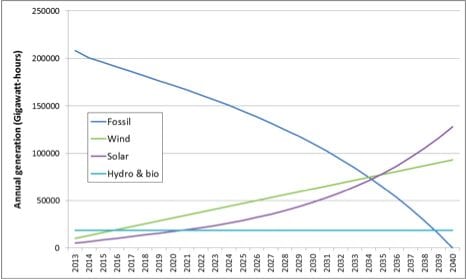Solar and wind energy could replace all fossil fuels in Australia by 2040 if their recent rate of deployment is maintained and slightly increased over the next 27 years – delivering the country with a 100% renewable electricity grid “by default” as early as 2040.
The stunning conclusions come from research from Andrew Blakers, the director of the Australian National University’s Centre for Sustainable Energy Systems. It notes that nearly all new electricity generation capacity in recent years has been wind and solar photovoltaics (PV), and demand has also ben falling since 2008.
Blakers says that if this situation continues then Australia will achieve renewable electricity system by 2040, as existing fossil fuel power stations retire at the end of their service lives and are replaced with renewables.
And the cost will be no greater than having fossil fuels because, as Bloomberg New Energy Finance notes, wind is already cheaper than new coal or gas-fired generation and solar soon will be. These are the critical points – because renewables are often painted as expensive when compared to fully-depreciated, 40 years fossil fuel plants. But not compared with the new capacity required to replace ageing fossil fuel fleet.
Blakers says his scenario works even using the more conservative technology cost forecasts prepared by the Bureau of Resource and Energy Economics. These forecasts are being updated, but they came to similar conclusions as BNEF on technology cost trends, just not quite as quickly.
The 100% by 2040 scenario is probably not that much different in scope to current trends. Australia was sitting at around 10 per cent renewables in 2010, and will probably end up with at least 25 per cent by 2020, given current trends on rooftop solar and the fixed 41,000GWh target for large scale renewables.
BNEF this week suggested that could jump to 46% by 2030 as wind and solar replace retiring fossil fuel plant, and the rate of those retirements would likely increase in the following decade. Some retirements could be accelerated as inflexible fossil fuel generation found itself squeezed out of the market by renewables and the emergence of storage options.
The scenario painted by Blakers includes:
- The currently-declining consumption of electricity stabilises at 2013 levels
- New capacity to replace retiring fossil fuel power stations at end of system life is exclusively wind and solar i.e. no new gas or coal plant.
- All existing fossil fuel power stations have retired by 2040
- Existing hydro and other renewables is maintained but not increased
- Capacity factors typical of good sites are achieved for wind (35%) and solar (20%). System lifetimes of 30 years are assumed.
- Wind and PV installation rates of 1 gigawatt (GW) per year each are sufficient to meet the Government’s 2020 renewable energy target. Note that about 1 GW of PV was installed in 2012 and about 1 GW of wind will be installed in 2013.
- In order to reach 100% renewables by 2040 the following installation rates are needed:
- Wind: 1 GW per year until 2040; AND
- Solar: 1 GW per year until 2020, then growing by 10% per year thereafter.
Blakers notes that South Australia already gets 29% of its electricity from wind and PV, and Tasmania gets almost all of its from hydro. ACT plans to get to 90% renewables by 2020.
This graph shows the rate of deployment out to 2040, with solar increasing by 10 per cent per year from 2020.
While this shows total generating capacity as it grows – in the case of wind and solar – and shrinks in the case of fossil fuels. Note the accelerated decline after 2030.










